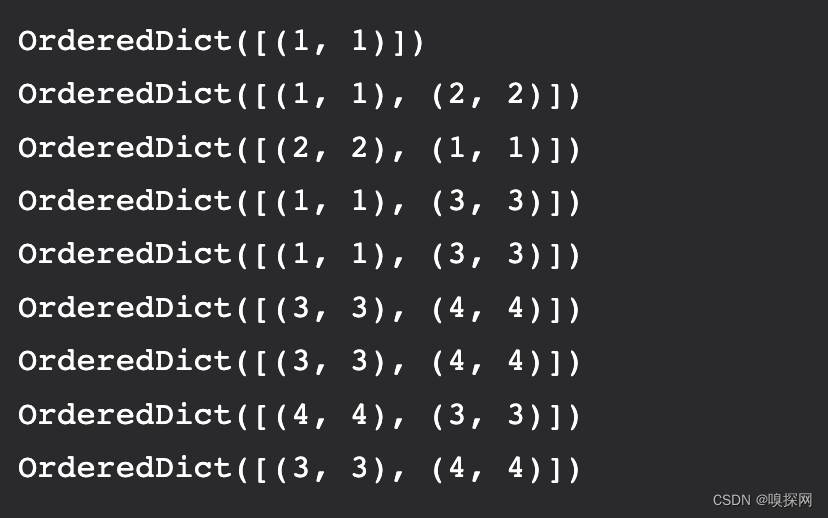LRU(Least Recently Used)缓存淘汰算法,可以理解为淘汰最近最少使用的缓存,是目前应用范围最广的缓存淘汰机制。
我们使用两种数据结构来实现 LRU Cache。
- 使用双向链表实现一个队列。队列的最大大小将等于可用帧的总数(缓存大小)。最近使用的页面将靠近队列前端,最近最少使用的页面将靠近后端。
- 一个以页码为键,以对应队列节点的地址为值的哈希表 。
当一个页面被引用时,需要的页面可能在内存中。如果它在内存中,我们需要将链表的节点分离出来,放到队列的最前面。
如果所需的页面不在内存中,我们将其加入内存。简单来说,就是在队列的最前面增加一个新节点,并更新哈希表中对应的节点地址。如果队列已满,即所有帧都已满,我们从队列的尾部移除一个节点,并将新节点添加到队列的前端。
LRU淘汰机制本质上很好理解,但实现起来并不那么容易,尤其是最佳的实现方式?
我们先来看最经典的实现方法
#include <bits/stdc++.h>
using namespace std;
class LRUCache {
// store keys of cache
list<int> dq;
// store references of key in cache
unordered_map<int, list<int>::iterator> ma;
int csize; // maximum capacity of cache
public:
LRUCache(int);
void refer(int);
void display();
};
// Declare the size
LRUCache::LRUCache(int n)
{
csize = n;
}
// Refers key x with in the LRU cache
void LRUCache::refer(int x)
{
// not present in cache
if (ma.find(x) == ma.end()) {
// cache is full
if (dq.size() == csize) {
// delete least recently used element
int last = dq.back();
// Pops the last element
dq.pop_back();
// Erase the last
ma.erase(last);
}
}
// present in cache
else
dq.erase(ma[x]);
// update reference
dq.push_front(x);
ma[x] = dq.begin();
}
// Function to display contents of cache
void LRUCache::display()
{
// Iterate in the deque and print
// all the elements in it
for (auto it = dq.begin(); it != dq.end();
it++)
cout << (*it) << " ";
cout << endl;
}
// Driver Code
int main()
{
LRUCache ca(4);
ca.refer(1);
ca.refer(2);
ca.refer(3);
ca.refer(1);
ca.refer(4);
ca.refer(5);
ca.display();
return 0;
}
输出: 5 4 1 3
借助Java特有的LinkedHashSet我们可以将上面的代码变得更加简洁易懂
import java.util.*;
class LRUCache {
Set<Integer> cache;
int capacity;
public LRUCache(int capacity)
{
this.cache = new LinkedHashSet<Integer>(capacity);
this.capacity = capacity;
}
// This function returns false if key is not
// present in cache. Else it moves the key to
// front by first removing it and then adding
// it, and returns true.
public boolean get(int key)
{
if (!cache.contains(key))
return false;
cache.remove(key);
cache.add(key);
return true;
}
/* Refers key x with in the LRU cache */
public void refer(int key)
{
if (get(key) == false)
put(key);
}
// displays contents of cache in Reverse Order
public void display()
{
LinkedList<Integer> list = new LinkedList<>(cache);
// The descendingIterator() method of java.util.LinkedList
// class is used to return an iterator over the elements
// in this LinkedList in reverse sequential order
Iterator<Integer> itr = list.descendingIterator();
while (itr.hasNext())
System.out.print(itr.next() + " ");
}
public void put(int key)
{
if (cache.size() == capacity) {
int firstKey = cache.iterator().next();
cache.remove(firstKey);
}
cache.add(key);
}
public static void main(String[] args)
{
LRUCache ca = new LRUCache(4);
ca.refer(1);
ca.refer(2);
ca.refer(3);
ca.refer(1);
ca.refer(4);
ca.refer(5);
ca.display();
}
}
输出: 5 4 1 3
还可以用Python特有的OrderedDict实现
from collections import OrderedDict
class LRUCache:
# initialising capacity
def __init__(self, capacity: int):
self.cache = OrderedDict()
self.capacity = capacity
# we return the value of the key
# that is queried in O(1) and return -1 if we
# don't find the key in out dict / cache.
# And also move the key to the end
# to show that it was recently used.
def get(self, key: int) -> int:
if key not in self.cache:
return -1
else:
self.cache.move_to_end(key)
return self.cache[key]
# first, we add / update the key by conventional methods.
# And also move the key to the end to show that it was recently used.
# But here we will also check whether the length of our
# ordered dictionary has exceeded our capacity,
# If so we remove the first key (least recently used)
def put(self, key: int, value: int) -> None:
self.cache[key] = value
self.cache.move_to_end(key)
if len(self.cache) > self.capacity:
self.cache.popitem(last = False)
# RUNNER
# initializing our cache with the capacity of 2
cache = LRUCache(2)
cache.put(1, 1)
print(cache.cache)
cache.put(2, 2)
print(cache.cache)
cache.get(1)
print(cache.cache)
cache.put(3, 3)
print(cache.cache)
cache.get(2)
print(cache.cache)
cache.put(4, 4)
print(cache.cache)
cache.get(1)
print(cache.cache)
cache.get(3)
print(cache.cache)
cache.get(4)
print(cache.cache)
输出

完整实现下载链接:
(包含各种语言:C、Python、Java、C++、C#等)
免费资源下载:LRU Cache







 本文介绍了LRU(Least Recently Used)缓存淘汰算法的工作原理及其常见实现方式,包括使用双向链表和哈希表的C++实现,Java中利用LinkedHashSet的简化实现,以及Python中OrderedDict的应用。这些实现都展示了如何在缓存满时删除最近最少使用的数据项。通过这些示例,读者可以更好地理解和掌握LRU算法的实现细节。
本文介绍了LRU(Least Recently Used)缓存淘汰算法的工作原理及其常见实现方式,包括使用双向链表和哈希表的C++实现,Java中利用LinkedHashSet的简化实现,以及Python中OrderedDict的应用。这些实现都展示了如何在缓存满时删除最近最少使用的数据项。通过这些示例,读者可以更好地理解和掌握LRU算法的实现细节。


















 346
346

 被折叠的 条评论
为什么被折叠?
被折叠的 条评论
为什么被折叠?








